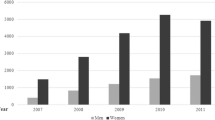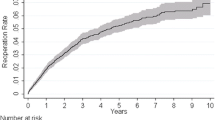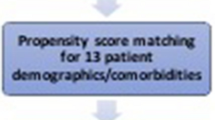Abstract
Background
Surgical outcomes are increasingly examined in an effort to improve quality and reduce medical error. The Nationwide Inpatient Sample (NIS) is a retrospective, claims-derived and population-based database and the Society of American Gastrointestinal Endoscopic Surgeons (SAGES) Outcomes Project is a prospective, voluntary and specialty surgeon database. We hypothesized that these two sources of outcome data would differ in regard to a single, commonly performed procedure.
Methods
Both the NIS, a national sample of all nonfederal hospital discharges, and the gastroesophageal reflux disease log of the SAGES Outcomes Project were queried for all fundoplications performed between 1999 and 2001 using either ICD-9 procedure code 44.66 or CPT codes 43280 or 43324. Patients with an emergency admission, age <17 years, and/or diagnoses for either esophageal cancer or achalasia were excluded. Both demographic and outcome variables were compared by either t-test or chi-square analysis, with a p value of <0.05 as significant.
Results
Both data sets were comparable for age and gender; however, the SAGES group had a higher rate of teaching hospital affiliation (71 vs 48%, p < 0.001). SAGES fundoplications had a consistently higher rate of comorbidities, including Barrett’s esophagus (2.3 vs 1.1%, p = 0.005). The NIS fundoplications had a clear trend toward more associated procedures, including cholecystectomy (7.2 vs 2%, p < 0.001). Complication rates for the NIS data set were higher, including pulmonary complications (1.7 vs 0.5%, p = 0.03). No statistically significant differences existed between the two data sets for either length of stay or mortality.
Conclusions
The two databases indicate that fundoplication is an operation with low morbidity and mortality. The SAGES Outcomes Project demonstrated that participating surgeons had a higher affiliation with teaching hospitals, higher reporting of comorbidity, and lower associated procedures than the NIS. Despite having more comorbidity and technical difficulty, patients from the SAGES Outcomes Project had equivalent or lower complication rates.
Similar content being viewed by others
References
Archer SB, Sims MM, Giklich R, et al (2000) Outcomes assessment and minimally invasive surgery: historical perspective and future directions. Surg Endosc 14: 883–890
Astor BC, Kaczmarek RG, Hefflin B, Daley WR (2000) Mortality after aortic valve replacement: results from a nationally representative database. Ann Thorac Surg 70: 1939–1945
Berthelsen CL (2000) Evaluation of coding data quality of the HCUP Nationwide Inpatient Sample. Topics Health Inform Manage 21: 10–23
Bridgewater B, Grayson AD, Jackson M, et al (2003) Surgeon specific mortality in adult cardiac surgery: comparison between crude and risk stratified data. Br Med J 327: 13–17
Centers for Medicare and Medicaid Services, Interim resource based practice expense data files, procedure code utilization by specialty, http://www.cms.hhs.gov/physicians/pfs/resource.asp (accessed July 2004)
Ferguson TB, Coombs LP, Peterson ED (2002) Preoperative B-blocker use and mortality and morbidity following CABG surgery in North America. J Am Med Assoc 287: 2221–2227
Ferguson TB, Dziuban SW, Edwards FH, et al (2000) The STS National Database: current changes and challenges for the new millennium. Ann Thorac Surg 69: 680–691
Finalyson SR, Laycock WS, Birkmeyer JD (2003) National trends in utilization and outcomes of antireflux surgery. Surg Endosc 17: 864–867
Ghali WA, Rothwell DM, Quan H, et al (2000) A Canadian comparison of data sources for coronary artery bypass surgery outcome “report cards.” Am Heart J 140: 402–408
Healthcare Cost and Utilization Project. Nationwide Inpatient Sample, Agency for Healthcare Research and Quality, Washington, DC. http://www.ahrq.gov/data/hcup (accessed July 2004)
Khaitan L, Apelgren K, Hunter J, Traverso LW (2003) A report on the Society of American Gastrointestinal Endoscopic Surgeons (SAGES) outcomes initiative: what have we learned and what is its potential? Surg Endosc 17: 365–370
Kohn LT, Corrigan JM, Donaldson MS (eds) (2000) To err is human: building a safer health system. National Academy Press, Washington, DC
Kuo PC, Douglas AR, Oleski D, et al. Determining benchmarks for evaluation and management coding in an academic division of general surgery. J Am Chem Soc 199: 124–130
Lum F, Schachat AP, Jampel HD (2002) The development and demise of a cataract surgery database. Joint Commission J. Quality Improvement 28: 108–114
Orringer MB (2001) STS database activities and you: “what’s in it for me?” Ann Thorac Surg 72: 1–2
Reed WP, Kilknenny JW, Dias CE, Wexner SD (2004) A prospective analysis of 3525 esophagogastroduodenoscopies performed by surgeons. Surg Endosc 18: 11–21
Rosner B (1990) Fundamentals of biostatistics. PWS-Kent, Boston
Traverso LW (2000) Surgical outcomes: what are they and why should they be measured? Surg Endosc 14: 103–105
Wexner SD, Garbus JE, Singh JJ (2001) A prospective analysis of 13,580 colonoscopies: reevaluation of credentialing guidelines. Surg Endosc 15: 251–261
Author information
Authors and Affiliations
Corresponding author
Additional information
Paper presented at the annual meeting of the Society of American Gastrointestinal Endoscopic Surgeons (SAGES), Denver, Colorado, USA, March/April 2004
Rights and permissions
About this article
Cite this article
Morton, J.M., Galanko, J.A., Soper, N.J. et al. NIS vs SAGES. Surg Endosc 20, 1124–1128 (2006). https://doi.org/10.1007/s00464-004-8829-6
Received:
Accepted:
Published:
Issue Date:
DOI: https://doi.org/10.1007/s00464-004-8829-6




